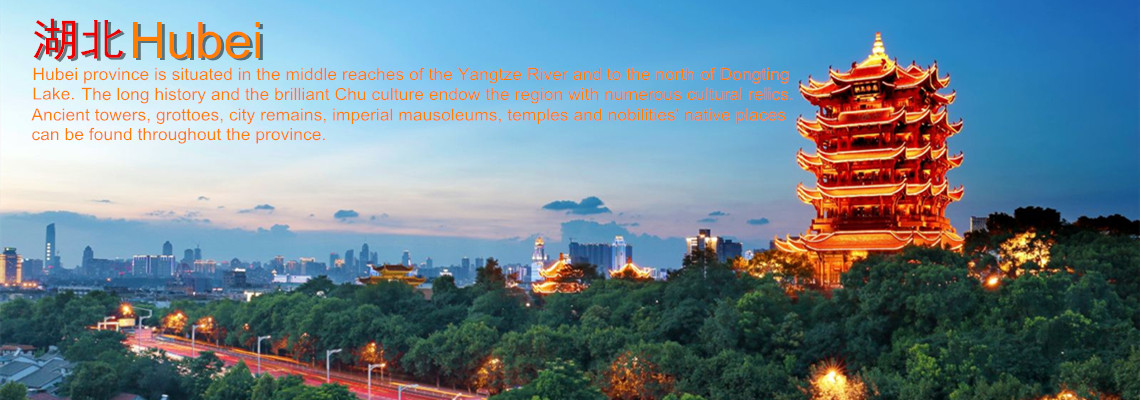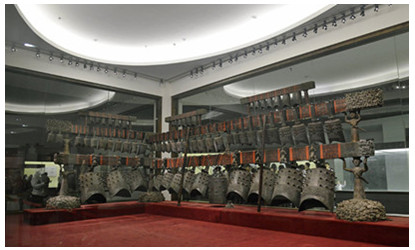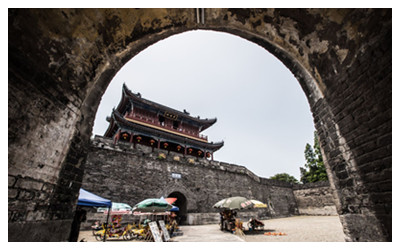Skype: neodalle-travel
Tel: +86 135 7447 2266
E-mail: sales@visitaroundchina.com

 Hubei was home to sophisticated Neolithic cultures.By the Spring and Autumn period (770–476 BC), the territory of today's Hubei was part of the powerful State of Chu. Chu was nominally a tributary state of the Zhou dynasty, and it was itself an extension of the Chinese civilization that had emerged some centuries before in the north; but it was also a culturally unique blend of northern and southern culture, and was a powerful state that held onto much of the middle and lower Yangtze River, with power extending northwards into the North China Plain.
Hubei was home to sophisticated Neolithic cultures.By the Spring and Autumn period (770–476 BC), the territory of today's Hubei was part of the powerful State of Chu. Chu was nominally a tributary state of the Zhou dynasty, and it was itself an extension of the Chinese civilization that had emerged some centuries before in the north; but it was also a culturally unique blend of northern and southern culture, and was a powerful state that held onto much of the middle and lower Yangtze River, with power extending northwards into the North China Plain.
Qin founded the Qin dynasty in 221 BC, the first unified state in the region. Qin was succeeded by the Han dynasty in 206 BC, which established the province (zhou) of Jingzhou in what is now Hubei and Hunan. The Qin and Han played an active role in the agricultural colonization of  Hubei, maintaining a system of river dikes to protect farmland from summer floods.Towards the end of the Han dynasty in the beginning of the 3rd century, Jingzhou was ruled by regional warlord Liu Biao. After his death, Liu Biao's realm was surrendered by his successors to Cao Cao, a powerful warlord who had conquered nearly all of north China; but in the Battle of Red Cliffs, warlords Liu Bei and Sun Quan drove Cao Cao out of Jingzhou. Liu Bei then took control of Jingzhou; he went on to conquer Yizhou (the Sichuan Basin), but lost Jingzhou to Sun Quan; for the next few decades Jingzhou was controlled by the Wu Kingdom, ruled by Sun Quan and his successors.During the Warring States period (475–221 BC) Chu became the major adversary of the upstart State of Qin to the northwest (in what is now Shaanxi province), which began to assert itself by outward expansionism. As wars between Qin and Chu ensued, Chu lost more and more land: first its dominance over the Sichuan Basin, then (in 278 BC) its heartland, which correspond to modern Hubei. In 223 BC Qin chased down the remnants of the Chu regime, which had fled eastwards, as part of Qin's bid for the conquest of all China.
Hubei, maintaining a system of river dikes to protect farmland from summer floods.Towards the end of the Han dynasty in the beginning of the 3rd century, Jingzhou was ruled by regional warlord Liu Biao. After his death, Liu Biao's realm was surrendered by his successors to Cao Cao, a powerful warlord who had conquered nearly all of north China; but in the Battle of Red Cliffs, warlords Liu Bei and Sun Quan drove Cao Cao out of Jingzhou. Liu Bei then took control of Jingzhou; he went on to conquer Yizhou (the Sichuan Basin), but lost Jingzhou to Sun Quan; for the next few decades Jingzhou was controlled by the Wu Kingdom, ruled by Sun Quan and his successors.During the Warring States period (475–221 BC) Chu became the major adversary of the upstart State of Qin to the northwest (in what is now Shaanxi province), which began to assert itself by outward expansionism. As wars between Qin and Chu ensued, Chu lost more and more land: first its dominance over the Sichuan Basin, then (in 278 BC) its heartland, which correspond to modern Hubei. In 223 BC Qin chased down the remnants of the Chu regime, which had fled eastwards, as part of Qin's bid for the conquest of all China.
The Song dynasty reunified the region in 982 and placed most of Hubei into Jinghubei Circuit, a longer version of Hubei's current name. Mongols conquered the region in 1279, and under their rule the province of Huguang was established, covering Hubei, Hunan, and parts of Guangdong and Guangxi. During the Mongol rule, in 1334, Hubei was devastated by an outbreak of the Black Death, which according to Chinese sources spread during the following three centuries to decimate populations throughout Eurasia.The incursion of northern nomadic peoples into the region at the beginning of the 4th century began nearly three centuries of division into a nomad-ruled (but increasingly Sinicized) north and a Han Chinese-ruled south. Hubei, to the South, remained under southern rule for this entire period, until the unification of China by the Sui dynasty in 589. In 617 the Tang dynasty replaced Sui, and later on the Tang dynasty placed what is now Hubei under several circuits: Jiangnanxi Circuit in the south; Shannandong Circuit in the west, and Huainan Circuit in the east. After the Tang dynasty disintegrated in the 10th century, Hubei came under the control of several regional regimes: Jingnan in the center, Wu (later Southern Tang) to the east, and the Five Dynasties to the north.
The Ming dynasty drove out the Mongols in 1368. Their version of Huguang province was smaller, and corresponded almost entirely to the modern provinces of Hubei and Hunan combined. While Hubei was geographically removed from the centers of the Ming power. During the last years of the Ming, today's Hubei was ravaged several times by the rebel armies of Zhang Xianzhong and Li Zicheng. The Manchu Qing dynasty which had much of the region in 1644, soon split Huguang into the modern provinces of Hubei and Hunan. The Qing dynasty, however, continued to maintain a Viceroy of Huguang, one of the most well-known being Zhang Zhidong, whose modernizing reforms made Hubei (especially Wuhan) into a prosperous center of commerce and industry. The Huangshi/Daye area, south-east of Wuhan, became an important center of mining and metallurgy.
In 1911 the Wuchang Uprising took place in modern-day Wuhan, overthrowing the Qing dynasty and establishing the Republic of China. In 1927 Wuhan became the seat of a government established by left-wing elements of the Kuomintang, led by Wang Jingwei; this government was later merged into Chiang Kai-shek's government in Nanjing. During World War II the eastern parts of Hubei were conquered and occupied by Japan while the western parts remained under Chinese control.
The province—and Wuhan in particular—suffered severely from the 1954 Yangtze River Floods. Large-scale dam construction followed, with the Gezhouba Dam on the Yangtze River near Yichang started in 1970 and completed in 1988; the construction of the Three Gorges Dam, further upstream, began in 1993. In the following years, authorities resettled millions of people from western Hubei to make way for the construction of the dam. A number of smaller dams have been constructed on the Yangtze's tributaries as well.
 Ask Questions ?
Ask Questions ?